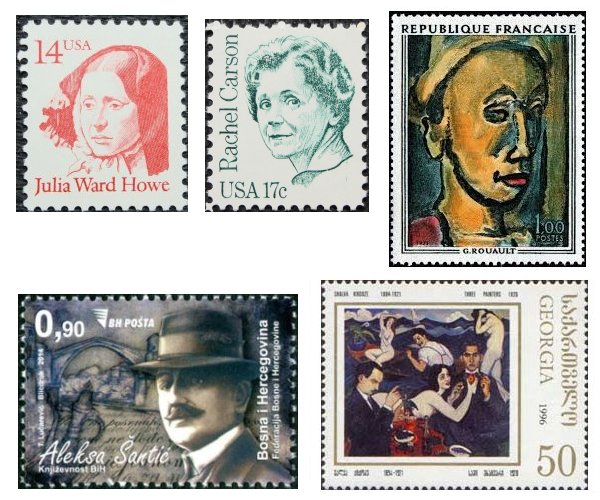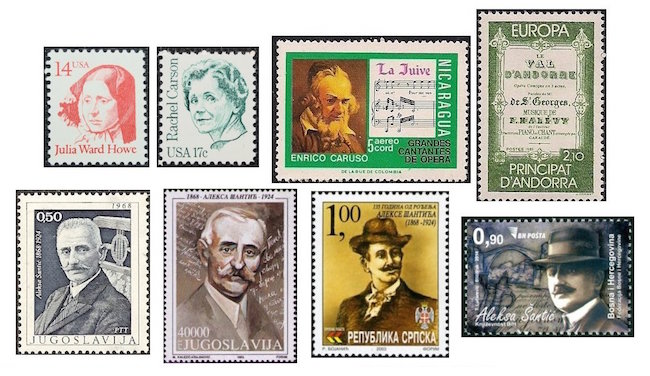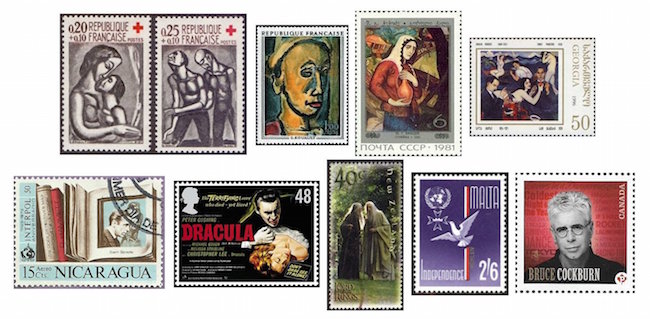The Arts on the Stamps of the World — May 27
An Arts Fuse regular feature: the arts on stamps of the world.

By Doug Briscoe
She is not the most noteworthy, perhaps, of today’s subjects on Arts on the Stamps of the World, but I daresay Julia Ward Howe (May 27, 1819 – October 17, 1910) has the most immediately recognizable name. Even so, it was 1987 before she was placed on the philatelic pedestal with an American stamp. A fighter for abolition, women’s suffrage, and pacifism, she was born in New York but lived mostly in Boston and Newport. She wrote the lyrics of “The Battle Hymn of the Republic” after meeting President Lincoln at the White House in 1861. Her other creations include several volumes of poetry, a few plays, and the magazine Woman’s Journal, which she founded in 1870.
One of America’s most important environmentalists was marine biologist Rachel Carson (1907 – April 14, 1964), whose famous book Silent Spring (1962) was a milestone in bringing awareness of environmental depredations to our collective consciousness. It helped lead to the creation of the EPA in 1970. Carson also wrote The Sea Around Us (1951) and The Edge of the Sea (1955). Note that her stamp comes from the same series, the Great Americans series, as the one for Julia Ward Howe, albeit an earlier issue from 1981.
There is no stamp issued specifically to honor French opera composer Fromental Halévy (1799 – 17 March 1862), but two refer to him obliquely. The first appeared in 1975 as part of a set of Nicaraguan stamps remembering great opera singers and shows Enrico Caruso in the rôle of Eléazar from Halévy’s best known opera La Juive (1835); the second, from 1985, was issued by the Principality of Andorra for no other reason, it would appear, than to spotlight Halévy’s 1848 comic opera Le Val d’Andorre (The Valley of Andorra).
The importance of Bosnian Serb poet Aleksa Šantić (27 May 1868 – 2 February 1924) may be measured, I suppose, by the number of times he has been honored on stamps of the region. I found four, two from the former Yugolavia and one each from Serbia and Bosnia. The author of nearly 800 poems and seven plays, Šantić edited the magazine Zora (Dawn) from 1896 to 1901 and was also president of a Bosnian music association. He was a proponent of the union of Southern Slavs and was taken hostage by the Austrians during World War I. He translated Heine, Schiller, and other German poets, as well as the poems of Svatopluk Čech.

The work of French artist Georges Rouault (1871 – 13 February 1958) can be seen on three stamps of his country: Love and The Blind Consoles the Seeing from his cycle Miserere (1948), on a pair of Red Cross stamps from 1961, and The Dreamer (1946), issued ten years later. Rouault’s love of art was encouraged by his mother, and he began as an apprentice painting and restoring glass. Some see in his later work a reflection of the heavy outlines and bright colors common to leaded glass designs. At the École des Beaux-Arts he became the favorite student of Gustave Moreau. (Rouault later became curator of the Moreau Museum in Paris.) His meetings with Matisse and others introduced Rouault to Fauvism, of which he became a strong proponent. He made the designs for Diaghilev’s premiere of Prokofiev’s ballet The Prodigal Son in 1929. As his life was coming to a close, Rouault decided to burn all of his unfinished canvases.
A painter of the following generation was the Georgian Shalva Kikodzé (1894 – 7 November 1921). He, Lado Gudiashvili, and David Kakabadze make up the troika of the region’s most important painters of the early 20th century. Born in a remote village, he studied in Moscow, made designs for a theater in Tbilisi, and then made his way to Paris, where he held an exhibition with his aforementioned countrymen in 1921, the year of his death at 27 from pulmonary disease. One stamp from the Soviet Union offers his Gurian woman holding a jar (1921), and one from independent Georgia reproduces Three Painters (1920). It seems reasonable to assume that this latter work is a self-portrait with Gudiashvili and Kakabadze.
There is no stamp for Dashiell Hammett (1894 – January 10, 1961) per se, but in 1973 Nicaragua cutely decided to pay tribute to Interpol for the organization’s 50th anniversary with a set of stamps featuring famous fictional detectives, and one of them is Sam Spade. Hammett’s name does appear on the spine of the book on the shelf next to the open volume displaying a picture of Humphrey Bogart and the Maltese Falcon.

May 27 is also the birthday of the late English actor Christopher Lee (1922 – 7 June 2015). Lee was highly accomplished in any number of ways, not just in being effectively scary. He spoke English, Italian, French, Spanish, and German fluently and Swedish, Russian, and Greek with moderate proficiency. Besides being an amateur operatic baritone, he narrated recordings of Prokofiev’s Peter and the Wolf (with the English String Orchestra under Yehudi Menuhin) and Stravinsky’s Soldier’s Tale (with the Scottish CO and Lionel Friend), both issued on Nimbus. Then quite late in life he became a committed performer in Heavy Metal! I found the extraordinary Mr. Lee on two stamps, one from Great Britain, a 2008 issue looking back on the Hammer Films, and a New Zealand stamp showing him as Saruman (with Ian McKellan’s Gandalf) from the Lord of the Rings movies. Funny that Lee’s birthday should fall one day after that of his long-time colleague and dear friend Peter Cushing.
Another stamp designer (you’ll pardon my unseemly preoccupation) was the Maltese artist Emvin Cremona (27 May 1919 – 29 January 1987). He was allegedly responsible for designing “most” (?!) of the Maltese stamps from 1957 to the 1970s, including the 1964 independence set from which I show one denomination. Some of Cremona’s nonphilatelic work adorns the UN building in New York and the WHO headquarters in Geneva.
Canadian singer-songwriter Bruce Cockburn (born May 27, 1945) has written 300 songs and made thirty albums. He was at Boston’s Berklee School of Music for three semesters in the mid-60s. His stamp, as I mentioned yesterday, comes from a block of four saluting contemporary Canadian popular musicians.
What a capital crew of writers there is who share this May 27 birthday! None of these deserving figures has a stamp, though: Arnold Bennett (1867 – 27 March 1931), John Cheever (1912 – June 18, 1982), Herman Wouk (who turns 102 today! born May 27, 1915), and John Barth (born 1930)! We also note the birthday of actors Vincent Price (1911 – October 25, 1993) and Joseph Fiennes (born 1970).
A graduate of the University of Massachusetts with a B.A. in English, Doug Briscoe worked in Boston classical music radio, at WCRB, WGBH, and WBUR, for about 25 years, beginning in 1977. He has the curious distinction of having succeeded Robert J. Lurtsema twice, first as host of WGBH’s weekday morning classical music program in 1993, then as host of the weekend program when Robert J.’s health failed in 2000. Doug also wrote liner notes for several of the late Gunther Schuller’s GM Recordings releases as well as program notes for the Boston Classical Orchestra. For the past few years he’s been posting a Facebook “blog” of classical music on stamps of the world, which has now been expanded to encompass all the arts for The Arts Fuse.
